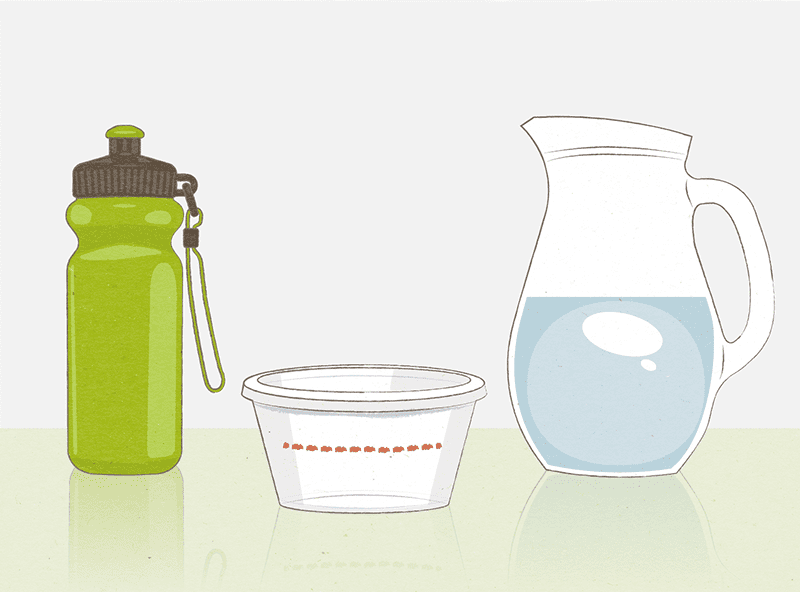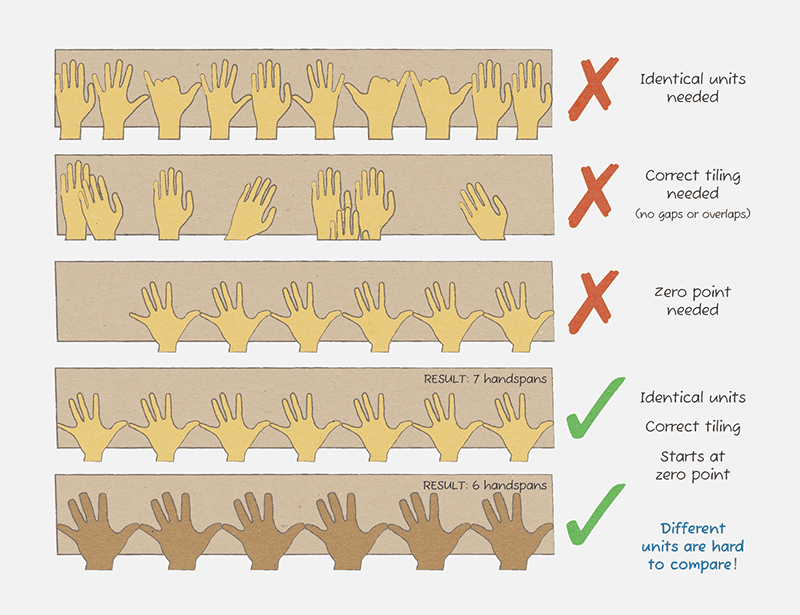Back to library
How kids learn this at school: Measurement
We frequently use measurement in our daily lives, either as a specific measurement or an estimate. Both types of measurement are very important. As adults we often do it without really thinking about it or realising how much we already know (see the article About this topic: Measurement in the portal for a refresher), but these are skills children need to learn.
The best way for children to learn about measurement is to get in there and do it! At school they will start with informal measurements (blocks, hands or other objects) and perceptual comparisons (which looks bigger/taller or feels heavier?), then build on these skills to introduce formal measurements (centimetres, millilitres, degrees) and learn to convert between different units (for example, centimetres to metres).
Over time children will become familiar with benchmarks (known or familiar measures that they can mentally compare things with), which will help them to make estimates.
Important measurement ideas
As children get hands-on experience of measuring and progress from informal measurements to formal ones, teachers will introduce the following key ideas about measurement.
Attributes of measurement
Children are shown that there are a range of different things that can be measured (attributes of measurement). For example, length, temperature, time, volume, capacity or mass (we usually use the word ‘weight’ in everyday language). Most of these attributes involve the same key ideas about measurement, so they may be introduced individually or together.
Comparison
Measurement is a comparison and at school children will be asked to compare the height, weight or capacity of different things in the classroom or playground.
First children will explore perceptual comparison. They may be asked to look at two things and say which they think is longer or heavier or holds the most liquid. For example, do they think their maths book is longer than their art folio, or does their drink bottle hold more water than a bowl? The idea is that they decide by looking at the two objects and making an estimate, then discussing what they see and how they might work out the answer.
Next, children will move on to direct comparison. Often working in pairs or small groups, children directly compare objects in their environment, such as the length of their reader compared to their exercise book.
They might do this by hefting, or lifting and handling, two objects to compare how heavy they are. For example, children might hold a book and a gluestick in each hand to see which feels heavier. This helps children develop a sense of weight and compare objects before they start to use formal measures.
Capacity and volume are a useful way to introduce indirect comparison. For example, when comparing the amount of water in their drink bottle and a jug, children may be encouraged to pour the water from their drink bottle into a third container, mark the height of the liquid, then empty the container and repeat the process with the water in the jug to see which holds more.
Activities that involve indirect measurements set the foundation for children to progress to formal measurement using standardised units (such as rulers, scales or measuring cups).

Working collaboratively and discussing results with their classmates helps motivate children and lets them work through their ideas of using comparisons to measure.
Units of measurement
When students have a good understanding of measuring being comparison, they will start measuring things in their environment using informal units of measure. For example, children may be asked to measure the length of the table using handspans. Children will then discuss their results, which are likely to vary a bit. Asking the students why the results are different will highlight some important measuring concepts. For example, students may realise that:
- each of their handspans may be different sizes. For example, some with fingers closer or further apart. This helps demonstrate that identical units are needed.
- their handspans may be different to other people’s because their hands are a different size. This helps demonstrate that standard units of measurement make it easier to compare or communicate measurements with other people.
- some people did not put their hand right at the edge of the table when they started measuring. This demonstrates that a zero starting point is needed.
- some people had gaps or overlaps between their handspans when measuring. This introduces the idea of tiling, or making sure that the equal units line up exactly without extra space or overlaps.

Talking about how and why their measurements were different helps children see these concepts in action and to understand the important features of accurate measuring.
Students will then be encouraged to use more uniform units of measure such as consistently-sized blocks, rather than more variable units like handspans. They will also start using formal, standardised units of measurement.
Estimation and benchmarking
Children will be asked to estimate before they make any kind of measurement, formal or informal. They will then compare their estimates to their actual measurements. Over time and with practice their estimates should become closer to the actual measurements.
Children will also develop benchmarks, which are known or familiar measurements that help them to estimate or get a sense of the size or amount of something without having to measure.
Estimation and benchmarking are important because they help children develop an internal sense of size and amount that they can use in daily life or to help them calculate with measurements later on. For example, how as an adult we might use a recipe that asks for vegetables to be cut into 1 cm slices – we are not actually going to measure them, we just have a sense of what 1 cm is.
Formal units of measurement
As children become more familiar and confident with the other important measurement ideas they will explore using more formal, standardised units of measure. Again, children will be given lots of practice in measuring different things that are relevant to them. For example, they may measure the distances jumped by students at an athletics day or measure the growth of plants in the school garden. Choosing practical examples that fit with the childrens’ interests shows them that measurement is a useful and necessary life skill.
When exploring formal measurements children may be asked to compare measurements (for example, which is longer or shorter, or heavier or lighter), and may also be asked to order their measurements (for example, from shortest to longest or lightest to heaviest) to help them build their understanding.
Equivalence and conversions
As children become more familiar with formal measurements they will start to learn that there is more than one way to talk about the same amount (equivalence) and that they can convert a measurement from one unit to another when they need to (conversion). For example, they may measure a pencil in centimetres and then work out what that is in millimetres to show that even when the units are different they both show the same measurement, or measure some water in cups and be asked to work out how many millilitres that is.
Sometimes children will notice that one unit of measurement is more precise or more useful for the task at hand than another. For example, when measuring a pencil in centimetres it may look like it is about 15 cm, but when measured again using a smaller unit (millimetres) we get a more precise measurement.
Children will learn to choose the most useful or appropriate unit for the thing they are measuring, and will come to understand the inverse relationship between the size of the unit and the count of the units. That is, the bigger the unit being used, the smaller the result of the measurement will be (the fewer units needed to show the amount being measured). For example, metres are a larger unit than centimetres, so there will be fewer of them needed to measure a basketball court than if we measured in centimetres. They will realise that bigger units are often more useful for large amounts and smaller units allow for more precision.
Summary
The best way for students to learn about measuring and develop confidence is to practise measuring lots of different things in their environment that are relevant to them. Noticing differences in measurements will highlight the important measurement ideas and set the foundation for accurate measuring as children progress from informal to formal measurements. Children will eventually be able to build on their ability to work and calculate with numbers (number operational skills) to be able to convert units of measurement and find equivalences when solving measurement problems.
